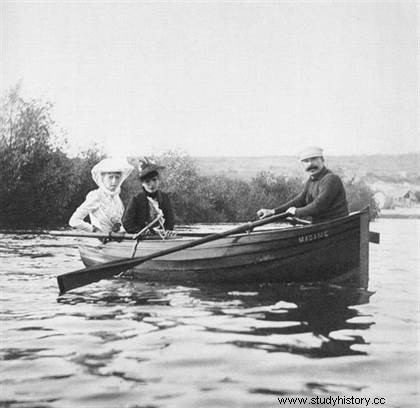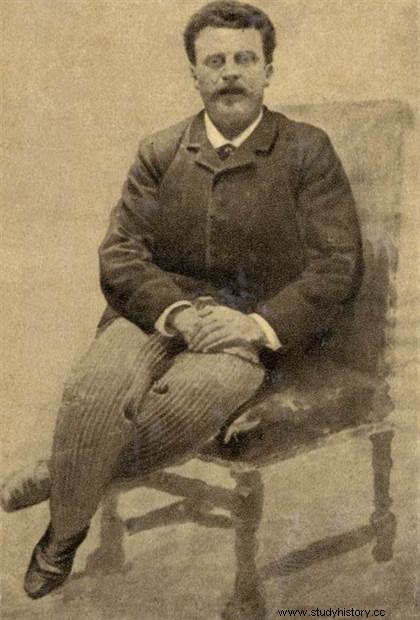 Guy de Maupassant (1850-1893) , prolific French writer despite his short existence left us six novels and nearly three hundred short stories , in a style that mixes realism and fantasy. Published from 1880 to 1891, these works realistically describe social and rural environments. Natural deeply distressed sound will deeply inspire pessimism and sometimes the horror that reigns in his works. He ends up losing his mindn in 1891 and died two years later.
Guy de Maupassant (1850-1893) , prolific French writer despite his short existence left us six novels and nearly three hundred short stories , in a style that mixes realism and fantasy. Published from 1880 to 1891, these works realistically describe social and rural environments. Natural deeply distressed sound will deeply inspire pessimism and sometimes the horror that reigns in his works. He ends up losing his mindn in 1891 and died two years later.
Biography of Guy de Maupassant
Guy de Maupassant was born at the beginning of August 1850 either at the Château de Miromesnil or at Fécamp with his maternal grandmother. For six years, he lived with sailors and fishermen; this is how the water, the sea and the boats will attract him all his life . After moving to the Château de Grainville-Ymauville in 1854 and the birth two years later of his brother Hervé, the family moved to the capital in 1859, Maupassant then entered the Lycée Impérial Napoléon (the current Lycée Henri IV) . After his parents separated, his mother took her sons to Normandy and the vicar of Etretat taught them grammar, arithmetic, Latin and catechism.
In 1863, Maupassant entered the Ecclesiastical Institution of Yvetot, but did not support the boarding school. He meets the painter Jean Baptiste Corot and begins to write his first "slightly dark" essays. At the age of eighteen, expelled from the Institution for licentious verse, he went to Rouen high school where he met the poet Bouilhet, then Flaubert; both take him under their wing and advise him. He finished his year by obtaining his baccalaureate in letters in 1869 and during the holidays, met Gustave Courbet , before going to Paris to begin a first year of law.
His first texts
The Franco-Prussian War of 1870 being close, he was one of the conscripts and was assigned to the Intendancy. The debacle, the desolation of the war inspired him with the tales known as "Boule-de-Suif », « Miss Fifi », « Two friends s ". Asking his father, a gatekeeper during the siege of the capital to intervene to change corps, he does not obtain a result and pays a replacement to leave the army. Aspiring to enter the administration, he first worked for free at the Library of the Ministry of the Navy in March 1872, while enrolled in law school. Finally, in February 1873, he received his first money:one hundred and twenty-five francs a month! And spends his weekends canoeing on the Seine...
At the end of the year, Maupassant founded the Union Society , takes the pseudonym of Joseph Prunier , begins to write his first story "The Flayed Hand which appears in the Lorraine Almanac of Pont à Mousson. He meets Edmond de Goncourt , then Stéphane Mallarmé , Émile Zola , Mendès and thanks to Flaubert , publishes articles in the daily newspaper La Nation .
 His first illness dates from 1876…he suffered from syphilis and frequent migraines . Spending the summer of 1877 in treatment, he wrote plays like "A la fleur de rose" or "The betrayal of the Countess of Rhune" which will be refused at the Comédie Française , but presented to Sarah Bernhardt, then another tale "The Holy Water Giver" and now earns two thousand one hundred francs a month. He is also working on his first novel “A Life » then a play « l’histoire du Vieux Temps » which premiered on February 19, 1879 and was well received.
His first illness dates from 1876…he suffered from syphilis and frequent migraines . Spending the summer of 1877 in treatment, he wrote plays like "A la fleur de rose" or "The betrayal of the Countess of Rhune" which will be refused at the Comédie Française , but presented to Sarah Bernhardt, then another tale "The Holy Water Giver" and now earns two thousand one hundred francs a month. He is also working on his first novel “A Life » then a play « l’histoire du Vieux Temps » which premiered on February 19, 1879 and was well received.
In the meantime, he meets Léon Gambetta , enters the Ministry of Public Instruction, is appointed Academy Officer and becomes secretary to Xavier Charmes. Following the publication of the poem "Une fille" he had to appear in court for insulting public morality and good morals... Flaubert intervened and in February 1880, Maupassant obtained a dismissal.
He is working on a collection of poems published by the collective of writers "les soirées de Médan" in which we find "Boule de Suif ". Maupassant becomes famous, the press tears up his writings to make soap operas. But in May 1880, Flaubert disappeared, Maupassant took care of the burial. Morally, he is very affected and his life will change.
Guy de Maupassant, writer and journalist
In the 1880s,He gradually left the Administration to do only writing and publishing . He published "Bouvard et Pécuchet" in La Nouvelle Revue and became one of the most important literary journalists . In the meantime, he made stays in Corsica, Etretat, Menton and Algeria which gave rise to articles-reports. The success is growing:around fifty tales a year, including Les Contes de la Bécasse (1883), Bel Ami (1885), The Horla and Other Fantastic Tales (1887), Strong as Death you (1889), The Tellie House r (1881) as well as many travelogues. But the disease is more present with back and eye pain (the right eye is seriously affected).
Thinking of the child who has just been born, a little Honoré Lucien Litzelmann in 1883, he built a house in Etretat (completed in June 1884), at the same time as his novel "Une Vie » which will be a great success and « Gustave Flaubert's Letters to Georges Sand and that he was named Société des Gens de Lettres s. The illegitimate couple (Maupassant and Joséphine Litzelmann) gave birth to a second child in June 1884, a little girl Jeanne Lucienne , while Maupassant worked on his new novel "Bel-Ami" and his "Contes du jour et de la nuit" which were published in March 1885. He was received into Parisian high society and notably met Proust> and Guitry .
 From February 1886, his health declined , may be due to the poor state of health of his brother Hervé, interned in Bron and who died in November 1889. To relax, he made several trips:Cannes, Antibes, Etretat, England (guest of Baron Ferdinand de Rothschild), Saint Raphaël, Chatou, North Africa while continuing to write a novel “Pierre et Jean” in eight weeks. He buys a boat in Marseilles, baptizes it "Bel-Ami" and makes several cruises in the Mediterranean Gulf. He spends a lot of time in Provence to rest, but is prone to intestinal disorders, hallucinations, anxiety attacks. Despite everything, he wrote and published the novels "La vie errante" and "Notre coeur".
From February 1886, his health declined , may be due to the poor state of health of his brother Hervé, interned in Bron and who died in November 1889. To relax, he made several trips:Cannes, Antibes, Etretat, England (guest of Baron Ferdinand de Rothschild), Saint Raphaël, Chatou, North Africa while continuing to write a novel “Pierre et Jean” in eight weeks. He buys a boat in Marseilles, baptizes it "Bel-Ami" and makes several cruises in the Mediterranean Gulf. He spends a lot of time in Provence to rest, but is prone to intestinal disorders, hallucinations, anxiety attacks. Despite everything, he wrote and published the novels "La vie errante" and "Notre coeur".
The Horla , emblematic work of Maupassant
The Horla is a fantastic tale written by Guy de Maupassant in 1886. This tale takes the form of a diary, in which the narrator recounts increasingly disturbing facts. Convinced that he is being chased by an invisible creature, he gradually descends into madness and ends up setting fire to his house, which he has barricaded on all sides. Uncertain of having got rid of the one he baptized the Horla, he sees only one possible outcome:suicide.
As the pages go by, the reader wonders if the narrator has gone mad, or if he should tremble with him. Until the end, Guy de Maupassant maintains this agonizing doubt:is the Horla the fruit of the narrator's imagination or does it really exist? By exploring the border between reason and madness, Guy de Maupassant stands out as a master of fantastic storytelling. When he writes the Horla, he himself is the victim of hallucinations, consequences of syphilis, a disease he contracted in his youth.
From January 1891 Maupassant begins to lose his mind . Struck in the throat, teeth, back, he can no longer write , left for the sun (Luchon, Saint Raphael, Divonne-les-Bains, Aix les Bains, Cannes), but began to be paralyzed at the end of the year 1891. He felt his end was near, wrote his will and made an attempt to suicide in January 1892. In this state, he was admitted to the clinic from January 7 and his property was placed under guardianship. His health deteriorated day by day in 1893 (convulsions then coma). Finally he died in Passy on July 6, 1893 at the age of 43 and is buried in the Montparnasse cemetery. His possessions were sold at auction at the end of December 1893.
Maupassant's main works
Novels
- One life (1883)
- Bel-Ami (1885)
- Peter and John (1888)
Tales and short stories
- Tallow Ball (1880)
- Tales of Woodcock (1883)
- The Adornment (1884)
- The Horla (1887)
To go further
- Guy de Maupassant by Nadine Satiat. Biography, Flammarion, 2002.
- Maupassant by Henri Troyat. Biography, Flammarion, 1992.
